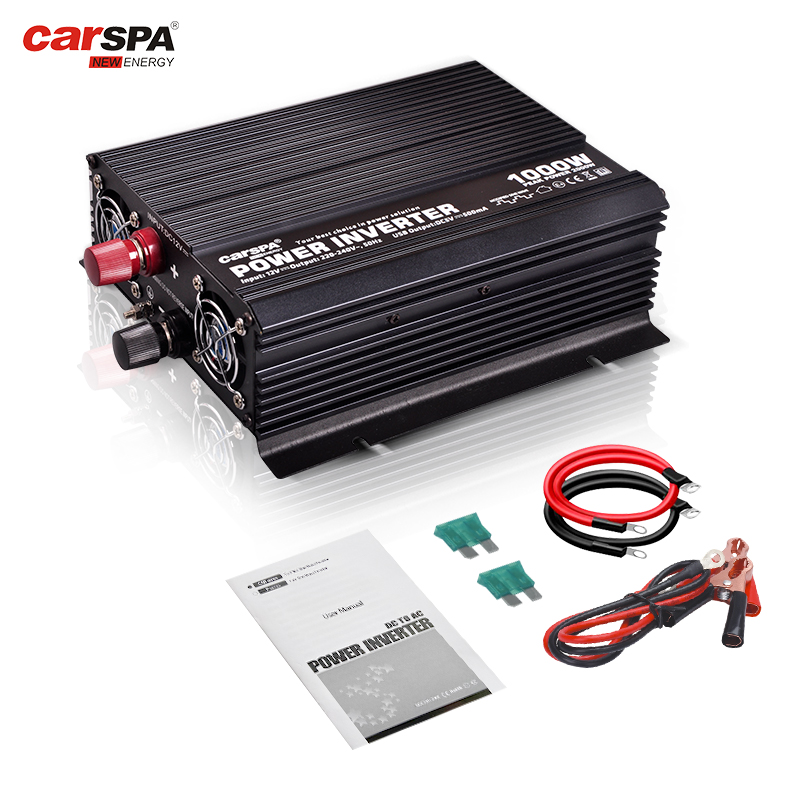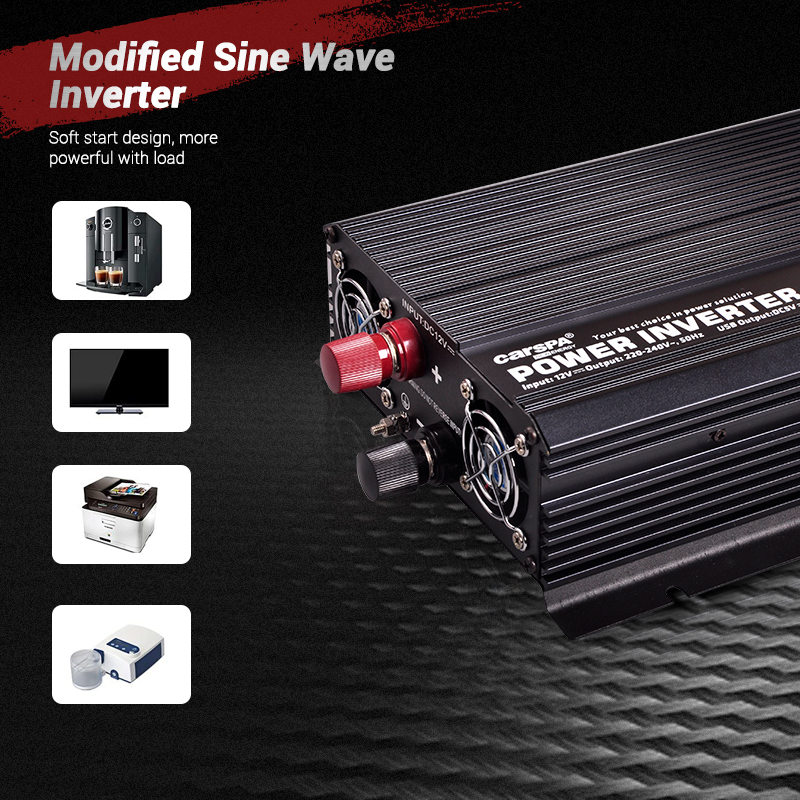What can I use a 1000W power inverter for?
In outdoor camping, RV travel, or emergency backup power supply scenarios, inverters are essential devices that can convert DC power into AC power, allowing a variety of electrical devices to work normally in an environment without power. So, what devices can an inverter with a power of 1000W be used to drive? What issues should be paid attention to during use? This article will answer the application scope and specific operation suggestions of 1000W inverters in detail through several key questions.
What is a 1000W inverter? What kind of power support can it provide?
A 1000W inverter is a device that can convert DC power (usually from a battery or solar system) into AC power (AC power) with a maximum output power of 1000 watts. This means that as long as the power of the connected device does not exceed 1000W, the inverter can provide a stable AC power supply to the device, allowing it to operate in an environment without socket power.
Main parameters and performance
Power range: The continuous power output of a 1000W inverter is 1000W, which is suitable for driving small household appliances, electronic equipment, etc. Some high-quality inverters also have instantaneous peak power (usually around 2000W) to cope with the instantaneous large current demand when some equipment starts.
Voltage output: 1000W inverters usually support 220V or 110V AC output (depending on the voltage standards of different countries), which can provide power support for most household appliances.
Waveform type: Common inverters on the market are divided into pure sine wave and modified sine wave. Pure sine wave inverters provide high-quality power, close to the mains, suitable for sensitive electronic equipment; although the modified sine wave inverter is cheaper, the waveform is not as stable as the pure sine wave, suitable for equipment with low power requirements.
1000W inverters are usually suitable for small and medium-sized appliances, suitable for daily camping, travel or temporary power outages and other occasions. When using, it is recommended to combine the power requirements of the equipment to ensure that the rated power of the inverter is not exceeded, so as to avoid the inverter tripping or damage due to overload.
What common electrical devices are suitable for 1000W inverters to drive?
1000W power can support a variety of household appliances and electronic devices, but the power requirements of different devices are different, so when choosing, it is necessary to judge whether it is suitable according to the power of the device. The following are some common electrical devices that 1000W inverters can support:
Lighting equipment: LED lights, table lamps and other low-power lighting equipment usually have a power of about 10-50W. 1000W inverters can easily drive multiple lighting devices, which is suitable for outdoor camping or power outages. Provide lighting support.
Small kitchen appliances: 1000W inverters can power some small kitchen appliances with lower power, such as coffee machines (about 300-600W), juicers (about 200-800W) and small rice cookers (about 300-700W). These devices are very convenient to use during camping or RV travel, and can provide users with basic cooking support.
Electronic devices: The power of electronic devices such as laptops (about 60-100W), mobile phone chargers (about 10-20W), and tablets (about 20-30W) is relatively low. The 1000W inverter can charge multiple devices at the same time, which is suitable for providing power needs for mobile office and entertainment outdoors or in vehicles.
Small refrigeration equipment: Small car refrigerators (about 60-100W) or portable refrigerators are usually low-power, and the 1000W inverter can easily support their operation, which is suitable for keeping food and drinks fresh during long-distance travel.
Power tools: Some low-power power tools, such as electric drills (about 300-500W) and small cutting machines (about 700W), can be powered by 1000W inverters when temporary repairs or outdoor construction are required. However, it should be noted that the starting power of some power tools may be large, so it is necessary to ensure that the inverter has sufficient peak power.
Actual example
Suppose a 1000W power inverter is used in outdoor camping to power a 100W portable refrigerator, a 50W lighting lamp, and a 60W laptop. The total power demand is 210W, and the inverter can continue to work for a long time. If a 300W coffee machine is added, the total power reaches 510W, which is still within the inverter's tolerance range and can meet daily eating, office and entertainment needs.
What restrictions should be paid attention to when using a 1000W inverter?
Although the 1000W inverter has a wide range of applications, there are still some limitations in actual use. The following points need special attention:
Power limit: The maximum power of a 1000W inverter is 1000W, so when using it, ensure that the total power of the connected devices does not exceed this limit. If the rated power is exceeded, the inverter may enter the overload protection mode and automatically shut down, or cause damage to the internal components of the inverter. For example, the power of high-power appliances such as microwave ovens and ovens is usually above 1000W, and it is not suitable to use a 1000W inverter.
Peak power demand: Some devices generate instantaneous peak power when starting, which may be much higher than their rated power. For some devices with high starting current, such as power tools and some compressors, it is necessary to confirm that the peak power of the inverter can meet the starting demand, otherwise the inverter may trip due to overload protection. For example, a 700W rated power drill may generate an instantaneous power demand of 1400W when starting, which requires the inverter to have sufficient peak power.
Waveform type: Inverters with different waveform types are suitable for different devices. Pure sine wave inverters are suitable for almost all electrical devices, while modified sine wave inverters are not suitable for power-sensitive devices, such as some TVs, stereos, and high-precision instruments. Therefore, if the device to be powered is more sensitive, it is recommended to choose a pure sine wave inverter.
Battery capacity: The duration of using the inverter depends on the capacity of the connected battery. For example, if a 12V, 100Ah battery is used to power a 1000W inverter, it can theoretically provide about 1 hour of full load operation (specific calculation is as follows). Therefore, users should evaluate the battery capacity before use and select the appropriate backup battery according to their needs to ensure continuous power supply needs in outdoor or long-term power outages.
Calculation example
Assuming that a 12V, 100Ah battery is used for power supply, the power inverter will be used for a full load of 1000W:
Usage time (hours) = battery capacity (Ah) × battery voltage (V) / inverter power (W)
=100×12/1000=1.2 hours
If it is operated at a lower power (such as 500W), the usage time will double. Therefore, when planning power needs, you can selectively reduce the load power to extend the usage time.
How to give full play to the performance of a 1000W inverter? What are some practical suggestions?
In order to better use the 1000W inverter, extend the life of the equipment and improve the efficiency of power utilization, the following are some practical suggestions:
Allocate power according to demand: When using the inverter, it is recommended to give priority to low-power equipment and reasonably allocate power needs. For example, try to avoid running multiple high-power devices at the same time, save power by using them in time-sharing mode, and avoid overload.
Check the battery status regularly: The inverter power supply depends on the continuous output of the battery, so the battery power should be checked regularly to ensure that it can provide stable power. Especially during long-term outdoor activities or power outage backup, it is recommended to prepare backup batteries with sufficient capacity to ensure the continuous operation of the inverter.
Choose a suitable waveform inverter: For the type of equipment that needs to be powered, choose a suitable waveform inverter. If electronic equipment and small appliances are mainly used, a modified sine wave inverter can meet the needs; if there are devices with higher power requirements, it is recommended to use a pure sine wave inverter to ensure the normal operation of the equipment and the stability of the power supply.
Pay attention to heat dissipation and dust prevention: The inverter will generate heat when working at high power. If the heat dissipation is poor, it may affect the working efficiency and may even cause the equipment to overheat and be damaged. Therefore, the inverter should be installed in a well-ventilated location to avoid long-term exposure to sunlight, especially when camping or traveling outdoors. At the same time, regularly clean the dust on the surface of the inverter to prevent the heat dissipation holes from being blocked.
Use protection devices: Installing fuses or circuit breakers in the inverter circuit can provide additional protection when the current is overloaded or short-circuited, and prevent circuit damage caused by abnormal current. In addition, if there is an abnormality in the operation of the equipment, disconnect the inverter power supply in time to avoid greater losses caused by equipment failure.
Conclusion
1000W inverters are widely used in outdoor travel, RV use, emergency backup and other scenarios, and can provide reliable power support for a variety of daily equipment. By reasonably planning power needs, selecting appropriate waveform types, and configuring batteries with sufficient capacity, users can give full play to the performance of 1000W inverters to meet various power supply needs.
During use, pay attention to details such as the power limit of the inverter, the peak demand of the equipment, and the battery status, which can better ensure the safety of the system and the long-term use of the equipment. Whether it is outdoor camping, long-distance travel or home backup, the 1000-watt power inverter is an ideal power solution to make life more convenient and safe.






